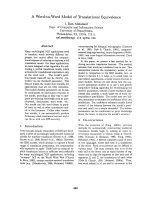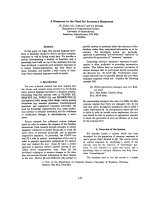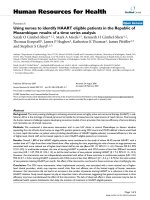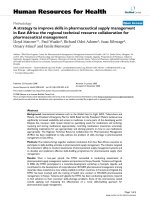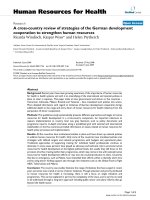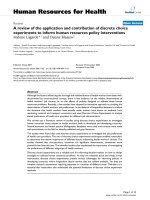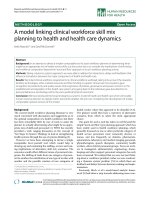Báo cáo sinh học: " A bridge to transcription by RNA polymerase" pot
Bạn đang xem bản rút gọn của tài liệu. Xem và tải ngay bản đầy đủ của tài liệu tại đây (792.94 KB, 4 trang )
Minireview
AA bbrriiddggee ttoo ttrraannssccrriippttiioonn bbyy RRNNAA ppoollyymmeerraassee
Craig D Kaplan and Roger D Kornberg
Address: Department of Structural Biology, Stanford University, 299 Campus Dr. West, Stanford, CA 94305, USA.
Correspondence: Roger D Kornberg. Email:
X-ray crystallographic studies on multisubunit RNA poly-
merases (RNAPs) from eukaryotes, bacteria and archaea have
revealed highly related enzymes with structurally conserved
active sites. For eukaryotic and bacterial enzymes, crystal
structures of transcribing complexes have been solved,
showing the locations of the DNA template, the nascent RNA
product and the substrate-binding site. Structural studies have
their limitations, however, which makes a comprehensive
functional screen of amino-acid substitutions in domains
critical for polymerase action published in Journal of Biology
especially useful. The results of the study by Robert
Weinzierl’s group (Tan et al. [1]) are in keeping with previous
structural work and will be a valuable resource for
interpreting future structural, single molecule and molecular
modeling experiments.
SSttrruuccttuurraall iinnffoorrmmaattiioonn aass tthhee ffoouunnddaattiioonn ffoorr ffuunnccttiioonnaall
ssttuuddiieess
Initial structural studies on the prokaryotic and eukaryotic
enzymes identified a conserved alpha-helical domain, termed
the bridge helix, that spans between two main lobes of the
enzyme (for a useful bibliography of the structural literature
on RNA polymerase, see Tan et al. [1]). Further studies
revealed interactions of this helix with the DNA template,
distorting its path adjacent to the nucleotide-addition site.
Moreover, the bridge helix appeared in two separate
conformations - ‘straight’ in a eukaryotic RNAP structure and
‘kinked’ in a bacterial RNAP structure - raising the possibility
that the conformational dynamics of the bridge might
directly control enzyme translocation: that is, bending of the
bridge helix might accompany movement of the polymerase
along the DNA template.
Lately, attention has turned from the bridge helix to an
adjacent domain of the enzyme, the trigger loop (Figure 1).
This loop is mobile or unstructured in many RNAP crystal
structures and appears conformationally flexible. In recent
structures of transcribing complexes, the trigger loop has been
seen to interact directly with template-specified nucleotide
substrates [2,3], suggesting critical roles in catalysis and
substrate selection. Indeed, mutations in trigger-loop residues
alter elongation rate, transcriptional pausing, response to
regulators, substrate selection and transcriptional fidelity [4].
The loop makes extensive contacts with the bridge helix, also
raising the possibility that the concerted actions of these two
AAbbssttrraacctt
A comprehensive survey of single amino-acid substitution mutations critical for RNA
polymerase function published in
Journal of Biology
supports a proposed mechanism for
polymerase action in which movement of the polymerase ‘bridge helix’ promotes
transcriptional activity in cooperation with a critical substrate-interaction domain, the
‘trigger loop’.
Journal of Biology
2008,
77::
39
Published: 2 December 2008
Journal of Biology
2008,
77::
39 (doi:10.1186/jbiol99)
The electronic version of this article is the complete one and can be
found online at />© 2008 BioMed Central Ltd
domains may underlie key RNAP dynamics during the
nucleotide-addition cycle.
Structural studies have important limitations in regard to
understanding the transcription mechanism at the molecular
level. First, transcribing complexes designed for crystallographic
studies are unavoidably compromised by alterations made to
prevent phosphodiester bond formation. In some structural
studies of eukaryotic RNAPs, as with those of numerous DNA
polymerases, putative reaction intermediates contain 3’-
deoxynucleotide-terminated nucleic acid primers to prevent
chain elongation [3,5]. In other eukaryotic RNAP structures
[6], and in a structure of a bacterial RNAP transcribing
complex [2], non-hydrolyzable substrates were used to
prevent phosphodiester bond formation. In either case, such
crippled elongation complexes may differ from native
complexes in critical aspects.
A second limitation of crystal structures is that they only
provide snapshots of stable conformations, failing to fully
reveal the dynamics involved in catalysis of phosphodiester
bond formation and translocation of RNAP along the
template. Current structures of transcribing RNAPs have not
attained atomic resolution, placing the reaction mechanism
out of reach. Indeed, as modeled, eukaryotic RNAP [3,5,6]
and bacterial elongation complexes [2] containing bound
substrates differ in putatively critical interactions between
trigger loop and nucleotide that could have profound
consequences for the RNAP catalytic mechanism. In light of
these shortcomings, biochemical studies such as those of
Tan et al. [1] are especially helpful.
AAnn aauuttoommaatteedd ppllaattffoorrmm ffoorr ffuunnccttiioonnaall ssttuuddiieess:: tthhee
RRNNAA ppoollyymmeerraassee ffaaccttoorryy
The current study by Tan et al. uses a highly automated, high-
throughput approach for the production and characterization
of RNAP variants developed previously by Weinzierl and
colleagues [7]. Their approach takes advantage of a
completely recombinant system for production of the RNAP
from the archaeon Methanocaldococcus jannaschii. This
recombinant archaeal polymerase is composed of nine
subunits, A’, A”, B’, B”, D, H, L, N and P (the other three
subunits of the native enzyme showed no detectable effect on
function in vitro and were therefore omitted). Recombinant
RNAPs may be expressed, purified, assembled and
characterized in batches of 96 RNAP variants over 1-2 days,
making large-scale analysis of systematically designed RNAP
substitution mutants feasible. In addition, the approach is
highly automated and can probably be implemented for the
study of any number of enzymatic systems, thus making it a
generally useful technology for protein-engineering studies.
In the ‘RNA polymerase factory’, all amino-acid substitutions
at a number of positions can be evaluated in parallel, giving
an essentially unbiased approach to structure-function
39.2
Journal of Biology
2008, Volume 7, Article 39 Kaplan and Kornberg />Journal of Biology
2008,
77::
39
FFiigguurree 11
RNA polymerase II elongation complex showing positions of bridge helix (BH) and trigger loop (TL).
((aa))
Cartoon representation of 10-subunit Pol II
elongation complex (PDB:2e2h) [3] with protein shown in charcoal gray, template DNA in blue, RNA product in red, and non-template DNA in
green. Buried within, near the active site, are the TL (cyan) and BH (magenta).
((bb))
Transparent view of (a) showing the position of the BH and TL
relative to the nucleic acid scaffold within Pol II.
((cc))
Rotated view of (b) showing the position of the BH and TL relative to the 3’ end of the RNA
product (the site of transcript elongation, shown by an arrow). This figure was created with PyMOL.
(a) (b) (c)
analysis that is not necessarily based on pre-existing
structural information or limited by numbers of mutants
that can be evaluated. Such high-throughput evaluation does
not have to rely on in vivo genetic identification of variants,
which can be limited by methods of mutagenesis that are
able to generate only subsets of all possible substitutions, or
by traditional site-directed mutagenesis approaches that rely
on prior rationales for the design of variants.
GGaaiinn ooff ffuunnccttiioonn mmuuttaannttss:: tthhee bbrriiddggee aanndd ttrriiggggeerr mmaayy
wwoorrkk ttooggeetthheerr
In previous proof-of-principle work [7], Weinzierl and
colleagues applied their automated analysis to all 19 amino-
acid substitution variants for M. jannaschii RNAP subunit A’
(mjA’) residue G825, within the bridge helix domain. In their
current study [1], they extend this analysis to an astonishing
323 variants within the bridge helix, comprising all 19 single
amino-acid substitutions within a 17 amino-acid stretch of
the helix. The authors also characterize an additional 38
substitutions, encompassing all 19 single amino-acid
substitutions of trigger-loop residues mjA” G72 and mjA” I98.
In regard to elucidating the interactions between bridge helix
and trigger loop, it is fascinating that the authors identify a
large number of super-activating substitutions within the
bridge helix as well as some within the trigger loop. It was
already known that certain trigger-loop substitutions in
bacterial RNAP and yeast RNA polymerase II (Pol II) allow
the enzymes to transcribe more quickly than wild-type
variants. In the study by Tan et al. [1] gain-of-function
substitutions are present within the region observed to bend
in crystal structures and along one side of the helix facing the
trigger loop. Double-substitution mutants containing gain-
of-function substitutions in both bridge helix and trigger
loop have no greater gain of activity than the most severe
single substitution, suggesting that the two domains
function together to promote transcription.
FFuunnccttiioonnaall eevviiddeennccee ffoorr bbrriiddggee hheelliixx ddyynnaammiiccss iinn tthhee
nnuucclleeoottiiddee aaddddiittiioonn ccyyccllee
As mentioned above, the bridge helix can be observed in a
number of conformations in crystal structures, with a kink or
a bend in various positions (Figure 2). In structures of
Thermus thermophilus (Tth) RNAP in the absence of nucleic
acids, the kink is quite pronounced [4,8]. Movement of the
trigger loop towards the bridge helix in a Saccharomyces
cerevisiae RNAP also appears to perturb the helix by altering its
path in the direction of the observed kink, although only to a
small extent [3]. In each case, the bend is in the same
direction - away from the trigger loop. A kinked bridge helix
has not yet been observed in a structure of the Tth RNAP
elongation complex, raising the possibility that an extreme
bridge helix kink may not necessarily function in transcription
elongation. The relative flexibility of the bridge helix, perhaps
not unexpected for such an isolated helix, is underscored by
the results of Tan et al. [1], who show that the bridge helix can
be somewhat tolerant to helix-breaking prolyl substitutions
along its length, including one substitution at the position of
the observed helix kink (mjA’ S824P) that super-activates
RNAP. Furthermore, kinked bridge helix structures reveal an
/>Journal of Biology
2008, Volume 7, Article 39 Kaplan and Kornberg 39.3
Journal of Biology
2008,
77::
39
FFiigguurree 22
Conformations of the bridge helix (BH) observed in crystal structures
of multisubunit RNAPs.
((aa))
Kinked orientation of the BH in some
Tth
RNAP crystal structures. BH from
Tth
RNAP holoenzyme without
nucleic acids [PDB:1iw7] (cyan) [8]. BH from
Tth
holoenzyme without
nucleic acids [PDB:2cw0] (slate blue) [9]. BH from
Tth
holoenzyme
without nucleic acids in the presence of streptolydigin [PDB:1zyr]
(yellow) [9].
((bb))
Straight orientation of the BH in
Tth
elongation
complex structures with or without nucleoside triphosphate (NTP)
substrate. BH from the
Tth
transcribing complex without NTP
substrate (the trigger loop (TL) in this structure is in the ‘out’ position
away from the substrate-addition site) [PDB:2o5i] (orange) [10]. BH
from
Tth
elongation complex with NTP substrate (the TL is folded ‘in’
and contacting the NTP substrate in this structure) [PDB:2o5j] (lime
green) [2].
((cc))
Mild perturbation of the Pol II BH in elongation complex
with matched NTP substrate in position for addition. BH from
S.
cerevisiae
(
Sce
) Pol II elongation complex without substrate, [PDB:1i6h]
(magenta) [11]. BH from the
Sce
Pol II elongation complex with
mismatched substrate (the TL is in the ‘out’ position away from
substrate-addition site in this structure) [PDB:1r9t] (teal) [5]. BH from
the
Sce
Pol II elongation complex with matched substrate (the TL is
folded ‘in’ and contacting the NTP substrate in this structure)
[PDB:2e2h] (blue) [3]. This figure was created with PyMOL.
(a)
(b)
(c)
interaction between two residues of the helix (analogs of
mjA’ residues 823 and 829) that may stabilize the kinked
conformation. Substitutions at either of these putatively
kink-stabilizing positions compromise RNAP activity to
various extents [1]. Notably, re-establishment of a possible
interaction between the two substituted positions results in
a moderate restoration of activity, consistent with an on-
pathway role for the observed interaction. These results
suggest that the kinked bridge helix promotes RNAP
activity, but whether in catalysis or translocation remains to
be determined.
FFuuttuurree ddiisssseeccttiioonn ooff RRNNAA ppoollyymmeerraassee ffuunnccttiioonn
The RNA polymerase factory has proved its usefulness for
the characterization of a large number of RNAP variants.
The next stage of this approach is likely to include
comprehensive analysis of trigger-loop residues and active-
site residues predicted to contact nucleotide substrates. A
subset of the mutants identified by Tan et al. should be
characterized with more traditional assays that are able to
directly measure RNAP elongation rate, substrate selection
and propensity for pausing. Information on such a wide
spectrum of mutants will benefit single-molecule studies in
which RNAP variants with specific defects can be used to
probe models of the transcription mechanism. In addition,
molecular modeling studies that aim to accurately describe
and elucidate the RNAP mechanism can be tested for
recapitulation of phenotypes demonstrated for a wide range
of RNAP variants, such as those described by Tan et al
Finally, biophysical studies able to directly probe and
characterize RNAP active-site dynamics, such as bridge helix
and trigger loop movement, and how such movement is
impacted by substrate binding and perturbation of RNAP
structure are likely to be important for understanding of the
RNAP mechanism at the near-atomic level. An eventual
complete elucidation of the RNAP mechanism, specifically,
the identification of the entire retinue of RNAP amino acids
required for catalysis and translocation, will be a first step
for understanding the regulation of RNAP activity in vivo.
AAcckknnoowwlleeddggeemmeennttss
We acknowledge funding from the NIH to RDK (GM36659 and
GM49985). Due to journal policy, we have only sparingly referenced
the literature and apologize to those whose work we were unable to
specifically reference.
RReeffeerreenncceess
1. Tan L, Wiesler S, Trzaska D, Carney HC, Weinzierl ROJ:
BBrriiddggee
hheelliixx aanndd ttrriiggggeerr lloooopp ppeerrttuurrbbaattiioonnss ggeenneerraattee ssuuppeerraaccttiivvee RRNNAA
ppoollyymmeerraasseess
J Biol
2008,
77::
40.
2. Vassylyev DG, Vassylyeva MN, Zhang J, Palangat M, Artsimovitch I,
Landick R:
SSttrruuccttuurraall bbaassiiss ffoorr ssuubbssttrraattee llooaaddiinngg iinn bbaacctteerriiaall RRNNAA
ppoollyymmeerraassee
Nature
2007,
444488::
163-168.
3. Wang D, Bushnell D, Westover K, Kaplan C, Kornberg R:
SSttrruuccttuurraall
bbaassiiss ooff ttrraannssccrriippttiioonn:: rroollee ooff tthhee ttrriiggggeerr lloooopp iinn ssuubbssttrraattee ssppeecciiffiicciittyy
aanndd ccaattaallyyssiiss
Cell
2006,
112277::
941-954.
4. Svetlov V, Nudler E:
JJaammmmiinngg tthhee rraattcchheett ooff ttrraannssccrriippttiioonn
Nat Struct
Mol Biol
2008,
1155::
777-779.
5. Westover KD, Bushnell DA, Kornberg RD:
SSttrruuccttuurraall bbaassiiss ooff
ttrraannssccrriippttiioonn:: nnuucclleeoottiiddee sseelleeccttiioonn bbyy rroottaattiioonn iinn tthhee RRNNAA
ppoollyymmeerraassee IIII aaccttiivvee cceenntteerr
Cell
2004,
111199::
481-489.
6. Kettenberger H, Armache KJ, Cramer P:
CCoommpplleettee RRNNAA ppoollyymmeerraassee
IIII eelloonnggaattiioonn ccoommpplleexx ssttrruuccttuurree aanndd iittss iinntteerraaccttiioonnss wwiitthh NNTTPP aanndd
TTFFIIIISS
Mol Cell
2004,
1166::
955-965.
7. Nottebaum S, Tan L, Trzaska D, Carney HC, Weinzierl RO:
TThhee
RRNNAA ppoollyymmeerraassee ffaaccttoorryy:: aa rroobboottiicc
iinn vviittrroo
aasssseemmbbllyy ppllaattffoorrmm ffoorr
hhiigghh tthhrroouugghhppuutt pprroodduuccttiioonn ooff rreeccoommbbiinnaanntt pprrootteeiinn ccoommpplleexxeess
Nucleic Acids Res
2008,
3366::
245-252.
8. Vassylyev DG, Sekine S, Laptenko O, Lee J, Vassylyeva MN,
Borukhov S, Yokoyama S:
CCrryyssttaall ssttrruuccttuurree ooff aa bbaacctteerriiaall RRNNAA
ppoollyymmeerraassee hhoollooeennzzyymmee aatt 22 66 ÅÅ rreessoolluuttiioonn
Nature
2002,
441177::
712-719.
9. Tuske S, Sarafianos SG, Wang X, Hudson B, Sineva E, Mukhopadhyay J,
Birktoft JJ, Leroy O, Ismail S, Clark AD Jr, Dharia C, Napoli A,
Laptenko O, Lee J, Borukhov S, Ebright RH, Arnold E:
IInnhhiibbiittiioonn ooff
bbaacctteerriiaall RRNNAA ppoollyymmeerraassee bbyy ssttrreeppttoollyyddiiggiinn:: ssttaabbiilliizzaattiioonn ooff aa
ssttrraaiigghhtt bbrriiddg
gee hheelliixx aaccttiivvee cceenntteerr ccoonnffoorrmmaattiioonn
Cell
2005,
112222::
541-52.
10. Vassylyev DG, Vassylyeva MN, Perederina A, Tahirov TH,
Artsimovitch I:
SSttrruuccttuurraall bbaassiiss ffoorr ttrraannssccrriippttiioonn eelloonnggaattiioonn bbyy
bbaacctteerriiaall RRNNAA ppoollyymmeerraassee
Nature
2007,
444488::
157-162.
11. Gnatt AL, Cramer P, Fu J, Bushnell DA, Kornberg RD:
SSttrruuccttuurraall
bbaassiiss ooff ttrraannssccrriippttiioonn:: aann RRNNAA ppoollyymmeerraassee IIII eelloonnggaattiioonn ccoommpplleexx
aatt 33 33 ÅÅ rreessoolluuttiioonn
Science
2001,
229922::
1876-1882.
39.4
Journal of Biology
2008, Volume 7, Article 39 Kaplan and Kornberg />Journal of Biology
2008,
77::
39
